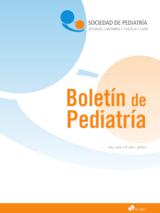Niño de 5 años con macrohematuria… ¿Sabríamos ante qué glomerulopatía estamos?
J. Caballero Ramos , C. Ríos Crooke , M.A. Ferrín Ferrín , A. Madruga Zaera , C. Urbano Ruiz , M.C. Criado Muriel
Bol. Pediatr. 2023; 63 (265): 162 - 165
Presentamos el caso de un escolar de 5 años que consulta en nuestro servicio por macrohematuria. Tras confirmarse el origen glomerular de la misma se sospecha glomerulonefritis aguda postestreptocócica debido al antecedente de infección faringoamigdalar, sin embargo el complemento es normal. Presenta deterioro rápido y progresivo de función renal, por lo que es diagnosticado de glomerulonefritis aguda rápidamente progresiva. Se realiza biopsia renal, donde se evidencia semilunas en un 81% de los glomérulos y depósitos de C3, compatible con glomerulonefritis aguda postinfecciosa. Inmediatamente después, se inicia tratamiento corticoideo presentando una evolución excelente y con recuperación completa de la función renal. Solo el 10-20% de la glomerulonefritis aguda postinfecciosas cursan con niveles de complemento normal, y solo el 0,5% de los casos se manifiesta como una glomerulonefritis rápidamente progresiva. La macrohematuria en niños puede suponer un reto diagnóstico. En ocasiones las manifestaciones son muy variable y superponibles a diferentes causa y hasta la biopsia no podemos llegar a un diagnóstico fiable.
Five-year-old with macrohematuria... Would we know what glomerulopathy we’re dealing with?
We present the case of a 5-year-old school boy who consulted our department for asymptomatic macrohematuria. After confirming the glomerular origin, poststreptococcal acute glomerulonephritis was suspected due to a history of pharyngotonsillar infection, however the complement is normal. He presents rapid and progressive deterioration of kidney function, which is why he is diagnosed with rapidly progressive acute glomerulonephritis. A renal biopsy was performed, showing crescents in 81% of the glomeruli and C3 deposits, compatible with acute post-infectious glomerulonephritis. Immediately afterwards, corticosteroid treatment was started, with excellent progress and complete recovery of kidney function. Only 10-20% of acute post-infectious glomerulonephritis present with normal complement levels, and only 0.5% of cases manifest as rapidly progressive glomerulonephritis. Macrohematuria in children can be a diagnostic challenge. Sometimes the manifestations are very variable and can be attributed to different causes and until the biopsy we cannot reach a reliable diagnosis.
Artículo completo (PDF) (73 kb.)
- Nefrourología
Buscar en el boletín
Año 2023, Volumen 63, Número 265

Boletín completo en PDF (8741 kb.)